
Although it is light on action, Tommy Lee Jones’ The Homesman is a slow-moving western that feels authentic and features powerful performances from Jones and the incredible Hilary Swank. The film also benefits from Miranda Otto, Grace Gummer and Sonja Richter – who make the most of their time on screen and force the audience to care about their characters through heartbreaking flashbacks and the hardships they endure.
The term ‘homesman’ refers to the now outdated pioneer occupation of returning someone to their family. In the film (which was directed by Jones), the journey involves taking three women, Arabella Sours (Gummer), Theoline Belknapp (Otto), and Gro Svendsen (Richter) back to a church in Hebron, Iowa.
The film opens by introducing the audience to the main character Mary Bee Cuddy (Swank), a frontier woman who lives alone and has a successful small farm. She is unmarried, but determined to find a proper mate for her farm. She is also extremely plan and bossy – something that is repeated several times by the men she approaches for marriage.
After the three women go crazy due to a harsh winter, the local preacher Reverend Dowd (John Lithgow) discuss one of the husbands taking the women to a church that can care for the insane, but none are willing to take the journey. With no man stepping forward, Cuddy accepts the job for the good of the women. As she is taking the wagon to pick up the women, she rides upon George Briggs (Jones), who is sitting on his horse with a noose around his neck. Briggs was squatting in an abandoned house and was driven out by the locals who thought he was a claim jumper. Cuddy agrees to cut him down if he will promise to go with her on the trip to Iowa.
The rest of the film centers on the long journey to Iowa, and the encounters Cuddy and Briggs come across – ranging from Indians who want their horses to wagon train leader who wants the women. As the journey takes place, Jones takes the time to tell the women’s stories through flashbacks that show how hard life truly was back in the 1850s Midwest. There is also a bit of action as Briggs comes across a hotel belonging to Aloysius Duffy (James Spader), and is turned away despite the fact the woman are starving and in desperate need of shelter. There are a few other twist in the film, but I don’t want to spoil them in the review.
Although the film moves at a rather slow pace, The Homesman benefits from Swank’s performance as Cuddy and Jones’ natural charisma as Briggs. The two talented actors are a perfect together and there are some great comedy moments from their interactions. Swank delivers the kind of strong independent woman you expect from the actress, but shows a vulnerability to Cuddy through her want of a husband and her reactions as men constantly claim she is plan and bossy.
Jones also impresses as a director taking a film set in a vast western landscape, but making the whole story feel small (and even claustrophobic at times) through its small cast, limited action and use of the wagon transporting the women. The film looks incredible on Blu-ray with its production detail and costuming truly standing out. It is also loaded with bonus material that takes you into the making of the film and features interviews with the cast. The behind-the-scenes features also include deleted scenes that further tell about the three women’s backstory and how the actors set about creating the three characters – which I really enjoyed.
Rich and deep in scope and perspective, The Homesman is a movie that will stay with you and leave you talking about it long after the end credits roll. From the broad scope of the landscape, to character-driven ambitions and heartache, Tommy Lee Jones has crafted a well-done masterpiece. Although it has a slow pace and may not be the kind of western everyone enjoys, I highly recommend taking the time to watch this film.